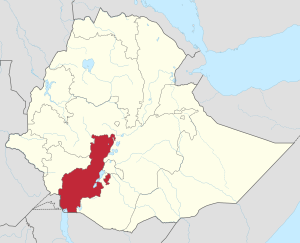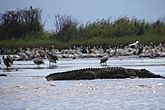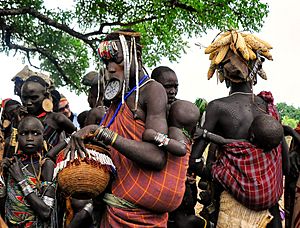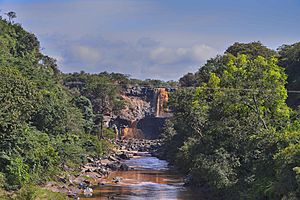Southern Nations, Nationalities, and Peoples' Region facts for kids
Quick facts for kids
Southern Nations, Nationalities, and Peoples' Region
የደቡብ ብሔር ብሔረሰቦችና ሕዝቦች ክልል
|
|||
|---|---|---|---|
|
Regional state
|
|||
|
From top to bottom: Sunset on Lake Awasa; Upper Omo River Valley; Lake Chamo; Welayta and Kambaata dance respectively
|
|||
|
|||

Map of Ethiopia showing Southern Nations, Nationalities, and People's Region
|
|||
| Country | |||
| Administrative headquarters | Hawassa | ||
| Area | |||
| • Total | 54,400 km2 (21,000 sq mi) | ||
| Area rank | 5 | ||
| Population
(2017)
|
|||
| • Total | 9,126,000 | ||
| • Rank | 4 | ||
| • Density | 167.76/km2 (434.5/sq mi) | ||
| ISO 3166 code | ET-SN | ||
| HDI (2019) | 0.488 low · 6th of 11 |
||
The Southern Nations, Nationalities, and Peoples' Region, often called SNNPR, is a large area in southwestern Ethiopia. It is a special kind of state, like a province. This region was created in 1992 when five smaller areas, called Regions 7 to 11, joined together.
The SNNPR shares its borders with Kenya to the south. It also touches the Ilemi Triangle, an area that Kenya and South Sudan both claim. To the west, it borders the South West Ethiopia Peoples' Region. The Oromia Region is to its north and east, and the Sidama Region is to its east.
The main city where the government of SNNPR is located is Hawassa. However, after the Sidama Region was formed in 2020, Hawassa is now outside the SNNPR's borders. The government plans to move its main office to a city inside the region in the future. The biggest cities within the region are Sodo and Arba Minch.
Contents
People and Population in SNNPR
In 2007, a study showed that the SNNPR had about 14.9 million people. Most of these people, almost 90%, lived in rural areas, meaning they lived in the countryside rather than in cities. This makes SNNPR the most rural region in Ethiopia.
The region covers about 105,887 square kilometers. This means there are about 141 people living in every square kilometer. In 2017, the population was estimated to have grown to over 19 million people.
The SNNPR government has been working to make sure more people have access to clean drinking water. By 2006, about 54% of the region had access to safe water. This was a big improvement from 15 years before, when only 10-15% had access. By 2008, this number increased to 63.6%.
Religions in SNNPR
People in the SNNPR follow different religions. Here is a look at the main religions in 1994 and 2007:
| Religion | 1994 Census | 2007 Census |
|---|---|---|
| Protestants | 21.8% | 38.5% |
| Orthodox Christians | 34.6% | 41.86% |
| Muslim | 15.2% | 14.1% |
| Traditional religions | 26.4% | 2.4% |
| Roman Catholics | 3% | 3.2% |
| Other religious affiliations | — | 0.5% |
Ethnic Groups in SNNPR
The SNNPR is home to more than 45 different ethnic groups. This makes it a very diverse region. Many of these groups have their own unique cultures and languages.
Here are some of the largest ethnic groups in the region:
| People | 1994 Census | 2007 Census |
|---|---|---|
| Welayta | 12% | 10.59% |
| Hadiya | - | 7.98% |
| Gurage | 15% | 19.54% |
| Gamo | - | 7% |
| Kafficho | - | 5.44% |
| Silt'e | - | 5.37% |
| Amhara | - | 4.10% |
Languages Spoken in SNNPR
The 2007 census showed that the most common languages spoken as a first language in the SNNPR include Sidama, Welayta, Hadiya, Gurage, Gamo, and Kafa.
Because there are so many different languages, Amharic is used as the official working language for the state government. Most students learn in their home language for the first eight years of school. After that, all higher education is taught in English.
Farming and Animals in SNNPR

Farming is a big part of life in the SNNPR. In 2004–2005, the region produced over 100,000 tons of coffee. This was almost half of all the coffee grown in Ethiopia!
Farmers in the region also raise many animals. They have millions of cattle, sheep, and goats. They also have horses, mules, donkeys, and lots of chickens. Beekeeping is also common, with many beehives producing honey.
One very important local plant grown in the SNNPR is called Enset. It is a major food source for many people in the region.
Leaders of SNNPR
The SNNPR has had several leaders, called Chief Administrators, since it was formed.
- Abate Kisho (1992–2001)
- Hailemariam Desalegn (2001–2006)
- Shiferaw Shigute (2006–2013)
- Dessie Dalke (2013–2018)
- Million Mathiwos (2018–2019)
- Erstu Yirdaw (2019 – present)
Areas and Zones in SNNPR
The SNNPR is divided into different administrative areas called zones and special woredas. A special woreda is like a smaller, self-governing area. Here are some of the zones and special woredas in the region:
| Number | Zone | Seat |
|---|---|---|
| 1 | Gamo Zone | Arba Minch |
| 2 | Gofa Zone | Sawula |
| 3 | Gedeo Zone | Dilla |
| 4 | Gurage Zone | Welkite |
| 5 | Hadiya Zone | Hosaena |
| 6 | Kembata Tembaro Zone | Durame |
| 7 | Silt'e Zone | Worabe |
| 8 | Debub Omo Zone | Jinka |
| 9 | Wolayita Zone | Sodo |
| 10 | Alaba Zone | Halaba Kulito |
| 11 | Amaro special woreda | Kele |
| 12 | Alle Special Woreda | |
| 13 | Basketo special woreda | Laska |
| 14 | Burji special woreda | Soyama |
| 15 | Dirashe special woreda | Gidole |
| 16 | Konso Zone | Karat |
| 17 | Yem special woreda | Fofa |
See also
 In Spanish: Región de las Naciones, Nacionalidades y Pueblos del Sur para niños
In Spanish: Región de las Naciones, Nacionalidades y Pueblos del Sur para niños
- List of districts in the Southern Nations, Nationalities, and Peoples' Region













